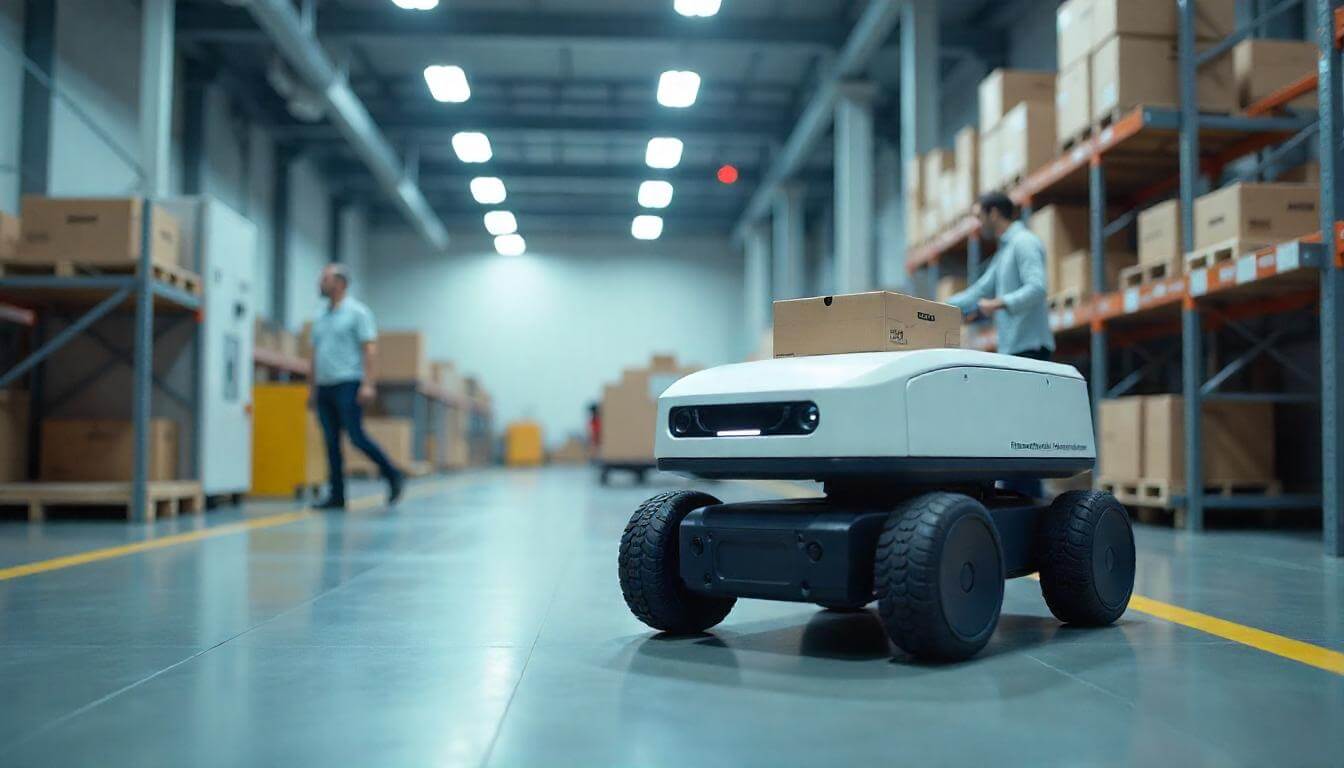The relentless pursuit of efficiency and precision is transforming global industries. Automation, powered by advanced robotics, stands at the forefront of this revolution. From manufacturing floors to logistics warehouses, intelligent machines are redefining productivity and operational capabilities. A recent $60 million robotics deal, spearheaded by the investment firm CVFF, marks a significant acceleration of this trend. This substantial funding is now enabling the widespread automation of industries, promising unprecedented levels of efficiency, safety, and innovation across diverse sectors. This article examines a major financial transaction (over $50 million) that is fundamentally reshaping industrial landscapes worldwide.
The Imperative for Automation: Addressing Industrial Challenges
Modern industries face a complex array of challenges. Labor shortages in critical sectors, the increasing demand for higher quality and faster production, and the need for enhanced safety in hazardous environments all point towards automation as a crucial solution. Traditional manual processes, while foundational for decades, often struggle to meet the scale, speed, and consistency required by today’s global economy. This creates bottlenecks, increases operational costs, and limits growth potential.
Furthermore, industries are under constant pressure to innovate and remain competitive. Implementing advanced robotics allows companies to reallocate human workers to higher-value tasks. It also improves overall operational resilience. Consequently, the drive to automate is no longer merely a matter of efficiency; it is a strategic imperative for long-term viability and market leadership.
The Rise of Industrial Robotics: Intelligence Meets Mechanics
Industrial robotics has evolved dramatically from simple, repetitive arms to sophisticated, intelligent systems. Modern robots are equipped with advanced sensors, computer vision, and artificial intelligence. These capabilities allow them to perform complex tasks with remarkable precision, adapt to changing environments, and even collaborate safely with human co-workers. This fusion of mechanics and intelligence unlocks new possibilities for automation.
Beyond traditional manufacturing, robots are now deployed in logistics for sorting and picking, in healthcare for surgical assistance, and in agriculture for harvesting and monitoring. Their ability to handle dangerous, dull, or dirty tasks enhances workplace safety and improves overall productivity. This continuous innovation in robotics makes them an increasingly attractive solution for a wide range of industrial applications.
CVFF’s $60 Million Robotics Deal: A Strategic Move
CVFF’s $60 million robotics deal is specifically targeting companies that develop and deploy autonomous mobile robots (AMRs) and collaborative robots (cobots) for industrial applications. This investment is set to accelerate the adoption of these advanced robotic solutions across manufacturing, warehousing, and intralogistics sectors. The significant capital infusion will enable the portfolio companies to scale their production, expand their R&D efforts, and penetrate new markets globally. This transaction underscores CVFF’s strategic vision to capitalize on the automation megatrend.
The funding will primarily be used for enhancing robotic AI capabilities, improving navigation systems, and developing more sophisticated human-robot interaction interfaces. A portion will also support global sales and deployment teams. This substantial backing positions the recipient companies to become leaders in their respective automation niches. Ultimately, it allows them to bring next-generation robotic solutions to a wider industrial audience.
Automating Industries: Revolutionizing Manufacturing
The manufacturing sector has long been at the forefront of robotics adoption, but this $60 million robotics deal is pushing new boundaries. Advanced robots are now performing tasks far beyond simple assembly. They include complex welding, precision machining, and intricate quality inspection. AI-powered vision systems enable robots to identify defects with microscopic accuracy, ensuring higher product quality and reducing waste.
Furthermore, collaborative robots (cobots) work alongside human operators. They handle physically demanding or repetitive tasks. This frees human workers to focus on more complex problem-solving and creative endeavors. Robotic automation also allows for greater customization and flexibility in production lines. Factories can quickly reconfigure to produce different product variants. This adaptability is crucial in today’s rapidly changing consumer markets.
Streamlining Logistics and Warehousing with Robotics
The logistics and warehousing sectors are experiencing a profound transformation due to robotics. E-commerce growth has dramatically increased the demand for faster and more accurate fulfillment. Autonomous mobile robots (AMRs) are revolutionizing warehouse operations. They transport goods, sort packages, and manage inventory with minimal human intervention. AMRs navigate dynamic environments, avoiding obstacles and optimizing routes in real-time.
This robotics deal is directly fueling the deployment of these AMRs in large-scale distribution centers. They significantly reduce the time and labor required for order picking and packing. Furthermore, robotic sorting systems can process thousands of items per hour, ensuring rapid delivery to customers. By automating these critical logistics functions, companies can achieve unparalleled levels of efficiency and throughput. They therefore meet the escalating demands of modern supply chains.
Enhancing Safety and Precision in Operations
Beyond efficiency, industrial automation, particularly through robotics, significantly enhances workplace safety. Robots can perform tasks in hazardous environments that would be dangerous for human workers. This includes handling heavy loads, working with toxic materials, or operating in extreme temperatures. By taking on these risks, robots protect human lives and reduce workplace injuries.
Moreover, robots deliver unparalleled precision and consistency. Unlike human operators who may experience fatigue or variability, robots perform repetitive tasks with the same accuracy every time. This leads to higher quality products and reduced errors, particularly in industries requiring stringent standards. This focus on both safety and precision is a key driver behind the increasing adoption of robotic solutions across various industries.
Economic and Strategic Impact for Businesses
The economic benefits of integrating advanced robotics are compelling. Businesses adopting these technologies often experience significant reductions in operational costs. This includes lower labor expenses for repetitive tasks and minimized waste due to increased precision. Productivity also sees a substantial boost. Robotic systems can operate 24/7, leading to higher throughput and faster time-to-market for products.
Strategically, embracing automation enhances a company’s competitive edge. It allows for greater agility in production. It also enables quicker responses to market demands. Furthermore, investing in advanced robotics positions companies as industry leaders. This attracts top talent and strengthens their brand reputation. The $60 million robotics deal therefore empowers businesses to not only survive but thrive in the evolving industrial landscape.
Navigating Challenges and Future Outlook
While the benefits of industrial automation are clear, challenges remain. The initial capital investment for robotic systems can be substantial. Integrating new robotic solutions with existing legacy infrastructure requires careful planning and technical expertise. Furthermore, ensuring the workforce is equipped with the necessary skills to manage and maintain these advanced systems is crucial. This often necessitates significant investment in training and upskilling programs.
However, the trajectory for industrial robotics is clear: continuous growth and increasing sophistication. Future innovations will likely include more versatile robots, enhanced AI capabilities for predictive maintenance, and seamless human-robot collaboration. The $60 million robotics deal serves as a powerful example of how strategic investment can accelerate the adoption of these transformative technologies. It pushes industries towards a more automated, efficient, and innovative future.
Conclusion: A New Era of Industrial Automation
CVFF’s $60 million robotics deal represents a significant milestone in the global journey towards industrial automation. By channeling substantial capital into cutting-edge robotic solutions, this investment is fundamentally transforming manufacturing, logistics, and other critical sectors. It fosters unprecedented levels of efficiency, enhances workplace safety, and drives continuous innovation. This commitment to advanced robotics is not merely about technological advancement; it is about building more resilient, productive, and competitive industries for the future. This strategic funding is undeniably ushering in a new era of automation, reshaping the very fabric of global commerce.

 Inside CVFF’s $60M Robotics Deal That Automated Industries">
Inside CVFF’s $60M Robotics Deal That Automated Industries">

Comentarios